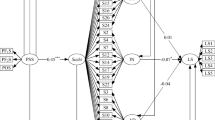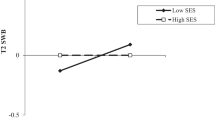Abstract
The current study examined the factorial structure of money attitudes and the relationship between changes in money attitudes and life satisfaction (LS) by using confirmatory factor analysis and multiple regression analysis to analyze a 2-year longitudinal database. The representative samples consisted of 906 Taiwanese adolescents in poverty. Compared with other competing models, results provided support for the five-factor structure of the adapted money attitude scale (MAS). Findings revealed that the relationship between changes in MAS power/prestige and LS was negative, whereas the association between changes in MAS quality and LS was positive. The results also showed that changes in MAS retention/time did not relate to changes in LS. The present study contributes to the understanding of the association between poor adolescents’ money attitudes and their LS in a Confucian context from the perspective of upward social comparison. The findings suggest that avoiding overemphasizing the importance of money and reducing comparison orientation may be the effective methods of improving LS for economically disadvantaged adolescents in Confucian culture.
Similar content being viewed by others
References
Burgess, S. M. (2005). The importance and motivational content of money attitudes: South Africans with living standards similar to those in industrialised Western countries. South African Journal of Psychology, 35(1), 106–126.
Burgess, S. M. (2007). Toward a theory on the content and structure of money attitudes. Advances in Consumer Research, 34, 682–683.
Burgess, S. M., Battersby, N., Gebhardt, L., & Steven, A. (2005). Money attitudes and innovative consumer behavior: Hedge funds in South Africa. Advances in Consumer Research, 32(1), 315–321.
Chen, H., & Lan, W. (1998). Adolescents’ perceptions of their parents’ academic expectations: Comparison of American, Chinese-American, and Chinese high school students. Adolescence, 33(130), 385–390.
Clark, A. E., & Senik, C. (2010). Who compares to whom? The anatomy of income comparisons in Europe. The Economic Journal, 120, 573–594.
Collins, R. L. (1996). For better or worse: the impact of upward social comparison on self-evaluations. Psychological Bulletin, 119(1), 51–69.
Conger, K. J., Rueter, M. A., & Conger, R. D. (2000). The role of economic pressure in the lives of parents and their adolescents: the family stress model. In L. J. Crockett & R. K. Silbereisen (Eds.), Negotiating adolescence in times of social change (pp. 201–233). New York: Cambridge University Press.
Diener, E., Emmons, R. A., Larsen, R. J., & Griffin, S. (1985). The satisfaction with life scale. Journal of Personality Assessment, 49(1), 71–75.
Enders, C. K., & Bandalos, D. L. (2001). The relative performance of full information maximum likelihood estimation for missing data in structural equation models. Structural Equation Modeling, 8(3), 430–457.
Eriksson, M., & Ng, N. (2015). Changes in access to structural social capital and its influence on self-rated health over time for middle-aged men and women: a longitudinal study from northern Sweden. Social Science & Medicine, 130, 250–258.
Festinger, L. (1954). A theory of social comparison processes. Human Relations, 7, 117–140.
Furnham, A. (1984). Many sides of the coin: the psychology of money usage. Personality and Individual Differences, 5(5), 501–509.
Gresham, A. B., & Fontenot, G. F. (1989). The differing attitudes of the sexes toward money: an application of the money attitude scale. In P. J. Gordon & B. J. Kellerman (Eds.), Advances in marketing (pp. 380–384). Cincinnati: South-Western.
Heine, S. J., Kitayama, S., Lehman, D. R., Takata, T., Ide, E., Leung, C., & Matsumoto, H. (2001). Divergent consequences of success and failure in Japan and North America: an investigation of self-improving motivations and malleable selves. Journal of Personality and Social Psychology, 81(4), 599–615.
Hsu, S. M., & Lin, L. H. (2007). A study of the concept of money and the consumption of upper-grade students in the elementary schools. Journal of Educational Practice and Research, 20(2), 1–28.
Huang, Y. (2016). Downward social comparison increases life-satisfaction in the giving and volunteering context. Social Indicators Research, 125, 665–676.
Inglehart, R., & Baker, W. E. (2000). Modernization, cultural changes, and the persistence of traditional values. American Sociological Review, 65, 19–51.
Khare, A. (2014). Money attitudes, materialism, and compulsiveness: scale development and validation. Journal of Global Marketing, 27, 30–45.
Kim, S. (2014). Does a money-is-all attitude cause alienation? A cross-cultural comparison of Korea, the US and Sweden. International Journal of Consumer Studies, 38, 650–659.
Kotrlik, J. W., Williams, H. A., & Jabor, M. K. (2011). Reporting and interpreting effect size in quantitative agricultural education research. Journal of Agricultural Education, 52(1), 132–142.
Ku, L. (2015). Development of materialism in adolescence: the longitudinal role of life satisfaction among Chinese youths. Social Indicators Research, 124(1), 231–247.
Lee, S. L., & Wang, T. M. (2011). Decomposing temporal changes in the Taiwanese child poverty rate with Das Gupta’s method. Tamkang Journal of Humanities and Social Sciences, 48, 125–159.
Lee, M. B., Liao, S. C., Lee, Y. J., Wu, C. H., Tseng, M. C., Gau, S. F., et al. (2003). Development and verification of validity and reliability of a short screening instrument to identify psychiatric morbidity. Journal of the Formosan Medical Association, 102(10), 687–694.
Li, Z. (2014). Between tradition and modernity: philosophical reflections on the modernization of Chinese culture. Beijing: Beijing Normal University Press.
Lin, C. C. (2015). Validation of the psychological well-being scale for use in Taiwan. Social Behavior and Personality, 43(5), 867–874.
Lin, S. P., Shu, Y. R., & Liao, C. Y. (2005). A study on the validity and reliability of Yamauchi and Templer’s money attitude scale: a case for private university student in Taiwan. Journal of Performance and Strategy Research, 2(2), 85–101.
Liu, T. L., Yen, J. Y., Ko, C. H., Huang, M. F., Wang, P. W., Yeh, Y. C., et al. (2010). Associations between substance use and body mass index: moderating effects of sociodemographic characteristics among Taiwanese adolescents. The Kaohsiung Journal of Medical Sciences, 26(6), 281–289.
Low, K. C. P. (2013). Materialism, Confucianism and Confucian values. Educational Research, 4(5), 403–412.
Marsh, H. W., Parada, R. H., & Ayotte, V. (2004). A multidimensional perspective of relations between self-concept (self description questionnaire II) and adolescent mental health (youth self-report). Psychological Assessment, 16(1), 27–41.
Masuo, D. M., Malroutu, Y. L., Hanashiro, R., & Kim, J. H. (2004). College students’ money beliefs and behaviors: An Asian perspective. Journal of Family and Economic Issues, 25(4), 469–481.
McLoyd, V. C., Jayaratne, T. E., Ceballo, R., & Borquez, J. (1994). Unemployment and work interruption among African American single mothers: effects on parenting and adolescent socioemotional functioning. Child Development, 65(2), 562–589.
Medina, J. F., Saegert, J., & Gresham, A. (1996). Comparison of Mexican-American and Anglo-American attitudes toward money. The Journal of Consumer Affairs, 30(1), 124–146.
Olson, D. H. (1986). Circumplex model VII: validation studies and FACES III. Family Process, 25(3), 337–351.
Oyserman, D. (2015). Culture as situated cognition. In R. Scott & S. Kosslyn (Eds.), Emerging trends in the social and behavioral Sciences: an interdisciplinary, searchable, and linkable resource (pp. 1–20). Hoboken: John Wiley & Sons.
Pavot, W., & Diener, E. (2009). Review of the satisfaction with life scale. Social Indicators Research, 39, 101–117.
Proctor, C. L., Linley, P. A., & Maltby, J. (2009). Youth life satisfaction: a review of the literature. Journal of Happiness Studies, 10(5), 583–630.
Roberts, J. A., & Sepulveda, C. J. (1999). Demographics and money attitudes: A test of Yamauchi and Templer’s (1982) money attitudes scale in Mexico. Personality and Individual Differences Journal, 27, 19–35.
Rogers, A., Fuller-Tyszkiewicz, M., Lewis, V., Krug, I., & Richardson, B. (2017). A person-by-situation account of why some people more frequently engage in upward appearance comparison behaviors in everyday life. Behavior Therapy, 48, 19–28.
Schneider, S. M., & Schupp, J. (2014). Individual differences in social comparison and its consequences for life satisfaction: Introducing a short scale of the Iowa–Netherlands comparison orientation measure. Social Indicators Research, 115, 767–789.
Shavelson, R. J., Hubner, J. J., & Stanton, G. C. (1976). Self-concept: validation of construct interpretation. Review of Educational Research, 46(3), 407–441.
Shek, D. T. L. (2008). Economic disadvantage, perceived family life quality, and emotional well-being in Chinese adolescents: a longitudinal study. Social Indicators Research, 85(2), 169–189.
Shek, D. T. L., & Liu, T. T. (2014). Life satisfaction in junior secondary school students in Hong Kong: A 3-year longitudinal study. Social Indicators Research, 117(3), 777–794.
Soba, M., & Aydin, E. (2012). The role of income level on sensitivity levels for similar product: a purchasing behavior study. International Journal of Humanities and Social Science, 2(18), 177–181.
Sohn, S. H., Joo, S. H., Grable, J. E., Lee, S., & Kim, M. (2012). Adolescents’ financial literacy: the role of financial socialization agents, financial experiences, and money attitudes in shaping financial literacy among South Korean youth. Journal of Adolescence, 35, 969–980.
Solberg, E. G., Diener, E., & Robinson, M. D. (2004). Why are materialists less satisfied? In T. Kasser & A. D. Kanner (Eds.), Psychology and consumer culture: the struggle for a good life in a materialistic world (pp. 29–48). Washington: American Psychological Association.
Tang, T. L. P. (1992). The meaning of money revisited. Journal of Organizational Behavior, 13(2), 197–202.
Tang, T. L. P. (1995). The development of a short money ethic scale: attitudes toward money and pay satisfaction revisited. Personality and Individual Differences, 19, 809–815.
Tang, T. L. P., Kim, J. K., & Tang, T. L. N. (2002). Endorsement of the money ethic, income, and life satisfaction: a comparison of full time employees, part time employees, and non-employed university students. Journal of Managerial Psychology, 17(6), 442–467.
Tang, T. L. P., Tang, D. S. H., & Luna-Arocas, R. (2005). Money profiles: the love of money, attitudes, and needs. Personnel Review, 34(5), 603–618.
Taormina, R. T., & Gao, J. H. (2013). Maslow and the motivation hierarchy: measuring satisfaction of the needs. American Journal of Psychology, 126(2), 155–177.
Tesser, A., Millar, M., & Moore, J. (1988). Some affective consequences of social comparison and reflection processes: the pain and pleasure of being close. Journal of Personality and Social Psychology, 54, 49–61.
Ting, S. C., & Tseng, C. F. (2013). Factors affecting the academic achievement of financially disadvantaged junior high school students: a case study of beneficiaries of the Taiwan fund for children and families. Taiwan Journal of Sociology of Education, 13(1), 1–42.
Vogel, E. A., Rose, J. P., Okdie, B. M., Eckles, K., & Franz, B. (2015). Who compares and despairs? The effect of social comparison orientation on social media use and its outcomes. Personality and Individual Differences, 86, 249–256.
Wheeler, L., & Miyake, K. (1992). Social comparison in everyday life. Journal of Personality and Social Psychology, 62, 760–773.
Wood, J. V. (1989). Theory and research concerning social comparisons of personal attributes. Psychological Bulletin, 106(2), 231–248.
Wu, M. Y., & Jou, Y. H. (2009). Moral beliefs of adolescents in Taiwan: impacts of social attachment. Taiwanese Sociology, 17, 61–100.
Wu, C. H., & Yao, G. (2006). Analysis of factorial invariance across gender in the Taiwan version of the satisfaction with life scale. Personality and Individual Differences, 40(6), 1259–1268.
Yamauchi, K. T., & Templer, D. I. (1982). The development of a money attitudes scale. Journal of Personality Assessment, 46(5), 522–528.
Yen, J. Y., Yen, C. F., Chen, C. C., Chen, S. H., & Ko, C. H. (2007). Family factors of internet addiction and substance use experience in Taiwanese adolescents. Cyberpsychology & Behavior, 10(3), 323–329.
Yu, A. B., & Yang, K. S. (1994). The nature of achievement motivation in collectivist societies. In U. Kim, H. C. Triandis, C. Kagitcibasi, S. C. Choi, & G. Yoon (Eds.), Individualism and collectivism: theory, method, and application (pp. 239–250). Newbury Park: Sage.
Zhang, B., & Kim, J. H. (2013). Luxury fashion consumption in China: factors affecting attitude and purchase intent. Journal of Retailing and Consumer Services, 20, 68–79.
Author information
Authors and Affiliations
Corresponding author
Ethics declarations
Conflict of Interest
The author declares that he has no conflict of interest.
Rights and permissions
About this article
Cite this article
Jhang, FH. The Five Dimensions of Money Attitudes and Their Link to Changes in Life Satisfaction Among Taiwanese Adolescents in Poverty. Applied Research Quality Life 13, 399–418 (2018). https://doi.org/10.1007/s11482-017-9531-x
Received:
Accepted:
Published:
Issue Date:
DOI: https://doi.org/10.1007/s11482-017-9531-x




